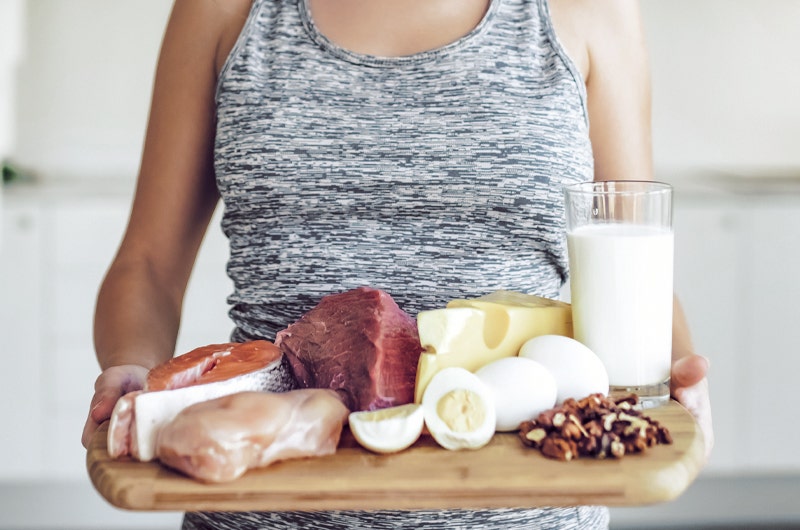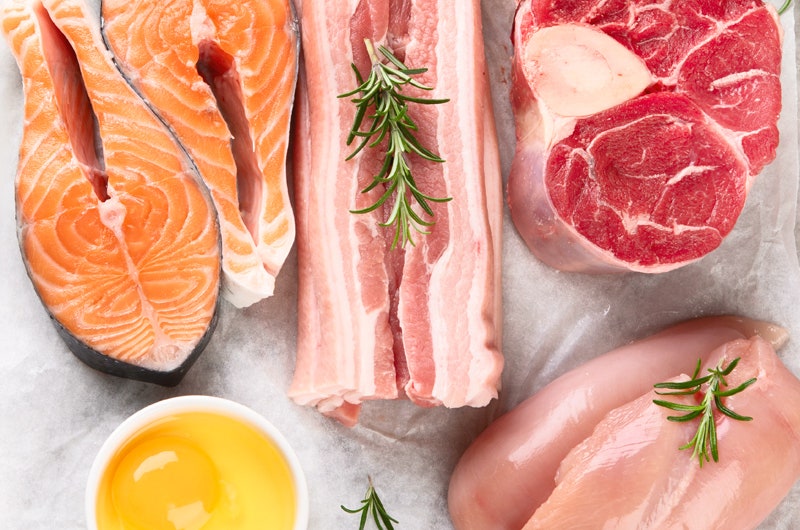Proteins are biological macromolecules consisting of a sequence of 20 simpler elements, amino acids, classified as essential (9) and non-essential according to the ability of the organism to synthesize them autonomously. The different combination of the various amino acids gives the protein a specific conformation, which greatly influences the function it will cover. Proteins are involved in almost all the activities that take place within the body: plastic, hormonal, signalling, regulatory, immune and more. We are faced with an extremely important element that we cannot do without. Yet the debates around them are more heated than ever, and the hover myths do not seem to run out.
We don’t need proteins
A deliberately provocative title; proteins are perceived as something unnecessary and indispensable, unfortunately, even by people not foreign to the world of nutrition.

For proteins, there is no reserve, unlike carbohydrates and lipids stored respectively as glycogen and fat tissue. Every day they undergo a high turnover due to the continuous alternation of demolition and reconstructive processes, which results in part a constant loss of molecules. Without a continuous supply of these, the organism finds itself having to draw from its own structures to obtain amino acids, self-damaging. Hiring them is not only necessary but fundamental!
Different sources in one meal? No thanks!
A meal should not be composed of different protein sources. Why this theory is so rooted is still a mystery.
We know that the organism is not able to distinguish foods, rather it decodes the meal in terms of nutrients. In the case of proteins, the source from which they derive is not distinguished, but the quantum-qualitative contribution of amino acids is perceived. If it were not so, the classic advice to combine cereals and legumes wobble, as well as the timeless pairing of rice and chicken (or the proteins of rice we forgot?).

The "heterogeneous" consumption of proteins does not involve any consequence, unless gastrointestinal problems for which it is appropriate to evaluate the signals that the body sends, respecting its own subjectivity. The combination of several protein foods is a valid strategy to increase the biological value of the meal, prolong the sense of satiety due to the different solubilities and digestibility of the various proteins, together with the overall composition of the same.
Protein = muscle
Many fitness starters are convinced that protein intake automatically leads to an increase in muscle mass. Although proteins represent about 20% of muscle composition and play an important role in the synthesis of myofibrils, we will never tire of reiterating that the most important growth stimulus is training against resistance, which prepares the ideal soil for the optimization of protein synthesis.

Without the right training stimulus, taking protein will bring health benefits, but little results for aesthetic purposes.
More is better
Daughter of the previous myth is the tendency to want to consume exorbitant amounts of protein. It is not uncommon to run into food plans with insane amounts of protein, devoid of any utility and especially not related to the subject. Protein requirements vary considerably according to different factors (sex, age, physiology/pathology, body composition, physical activity). There is no real and proven utility in consuming protein quotas significantly higher than that which the updated scientific literature recommends for years with various ranges of intake for each situation.
The myth of 30 gr. per meal
This false belief concerns a hypothetical protein absorption limit of around 30 grams per meal. A wrong concept, if we consider absorption is influenced by countless factors and does not represent an immediate event. One cannot reason by watertight compartments ignoring physiology in its totality. A high protein meal will be digested more slowly, but the individual amino acids will still be placed in the bloodstream although with longer times (which in some ways represents an advantage).
The above quantity is scientifically confirmed in some studies that show the effectiveness of about 20-30g of high-quality proteins in stimulating the maximum muscle protein synthesis within 24 hours, but this is not linked to absorption limits.
Animal and vegetable proteins: the eternal diatribe
Which sources are better? From a qualitative point of view, the superiority of animal sources is established, given the complete amino acid profile. On the other hand, a careful association of plant sources ensures the contribution of all the elements that you need.

Both sources present problems related mostly to the food matrix that contains them: animal sources may contain amounts of fat that increase the caloric intake, the plant sources instead are less digestible because of the fibres. The solution is to find a compromise, consuming both sources in the right proportions to benefit from all the nutritional characteristics of which they are equipped.
Protein powder is bad for you
Protein powder is the most consumed food supplement in the world. As we know there are different types, origins and formulations according to more or less specific and technical criteria.

Contrary to popular opinion, the use of these supplements does not pose any danger to health: they are nothing more than a concentrated source of what we would get by metabolizing solid food. The advantages are practicality, purity and cost when compared to the net protein quantity. This does not encourage exclusive consumption or intake if sufficient protein intake is obtained from solid.
Proteins and kidneys
Kidney function is investigated by monitoring certain parameters (e.g., albuminuria, proteinuria and egfr). In particular, egfr (estimated glomerular filtration rate) identifies renal filtration capacity. Low egfr values are associated with more and more critical stages of kidney failure, while high values generally indicate good organ functioning.
A diet with a high protein content results in nephrotic subjects a considerable overload for the kidneys. The protein intake is however adequately guaranteed through amino acid formulations and dietary strategies ad hoc and not opting for total exclusion. In healthy subjects, the literature shows no concrete evidence that indicates the association between a protein excess and the onset/progression of kidney disease. It is shared that the increase in egfr posthumously to protein ingestion is a physiological adaptation.
Protein and bone decalcification
Another myth associates protein consumption with the phenomenon of bone decalcification and the onset of skeletal disorders, due to an increase in calcium excretion. Proteins for bone health are fundamental, constituting the scaffolding useful for the organization of the mineral matrix.

Calcium homeostasis is mostly dependent on fine hormonal regulation, used by parathormone, calcitonin, and vitamin D.
Proteins and tumours
We could only conclude with the last of the legends: do proteins cause tumours? We start from the assumption that cancer is a multifactorial disease for which risk or related factors are identified and talking about certain causality is always risky.
In some neoplastic pathologies, high levels of a molecule known as IGF1 (insulin-like growth factor, or similar insulin growth factor) have been found to have powerful anabolic effects necessary for cell growth. The proteins, being able to raise (albeit in physiological range) the IGF1, have been demonized and identified as a cause. Reasoning in this way is extremely simplistic and simplistic; it is appropriate to assess the context in which certain arguments are dealt with and inferred conclusions.
Finally, certain protein foods are classified as pro-carcinogenic elements: the problem here is not the proteins themselves, but the molecules used/derived from the processing process, the harmfulness of which is well known (the classic case of processed meat).
Bibliography:
Butterfield GE. Whole-body protein utilization in humans. Med Sci Sports Exerc. 1987.
Schoenfeld BJ, Aragon AA. How much protein can the body use in a single meal for muscle-building? Implications for daily protein distribution. Journal of the International Society of Sports Nutrition. 2018.
Jäger R et al. International Society of Sports Nutrition Position Stand: protein and exercise. J Int Soc Sports Nutr. 2017.
Norton LE, Wilson GJ. Optimal protein intake to maximize muscle protein synthesis: examinations of optimal meal protein intake. Agro Food Industry Hi-Tech. 2009.
Cuenca-Sánchez M, Navas-Carrillo D, Orenes-Piñero E. Controversies Surrounding High-Protein Diet Intake: Satiating Effect and Kidney and Bone Health. Adv Nutr. 2015
Moore DR, Robinson MJ, Fry JL, Tang JE, Glover EI, Wilkinson SB, Prior T, Tarnopolsky MA, Phillips SM. Ingested protein dose response of muscle and albumin protein synthesis after resistance exercise in young men. Am J Clin Nutr. 2009 Jan;89(1):161-8. doi: 10.3945/ajcn.2008.26401. Epub 2008 Dec 3. PMID: 19056590.
Effects of Protein Intake on Renal Function and on the Development of Renal Disease. Available from: https://www.ncbi.nlm.nih.gov/books/NBK224634
Pasiakos SM, McLellan TM, Lieberman HR. The effects of protein supplements on muscle mass, strength, and aerobic and anaerobic power in healthy adults: a systematic review. Sports Med. 2015 Jan;45(1):111-31. doi: 10.1007/s40279-014-0242-2. PMID: 25169440.
Brenner BM, Meyer TW, Hostetter TH. Dietary protein intake and the progressive nature of kidney disease: the role of hemodynamically mediated glomerular injury in the pathogenesis of progressive glomerular sclerosis in aging, renal ablation, and intrinsic renal disease. N Engl J Med. 1982 Sep 9;307(11):652-9. doi: 10.1056/NEJM198209093071104. PMID: 7050706.
Martin WF, Armstrong LE, Rodriguez NR. Dietary protein intake and renal function. Nutr Metab (Lond). 2005;2:25. Published 2005 Sep 20. doi:10.1186/1743-7075-2-25
Laron Z. Insulin-like growth factor 1 (IGF-1): a growth hormone. Mol Pathol. 2001;54(5):311-316. doi:10.1136/mp.54.5.311


Comments
Write a comment about the article